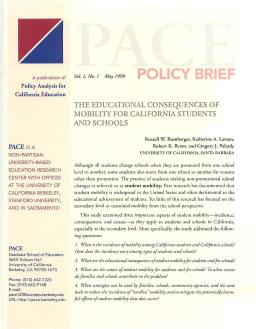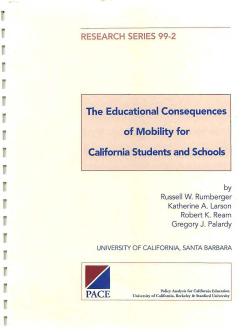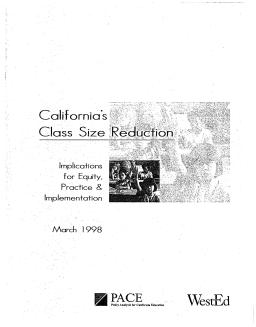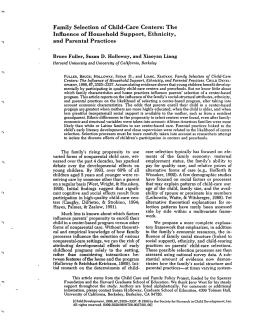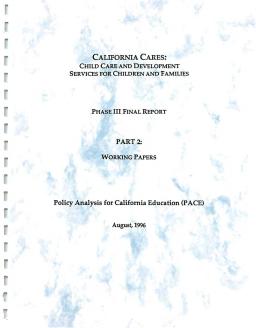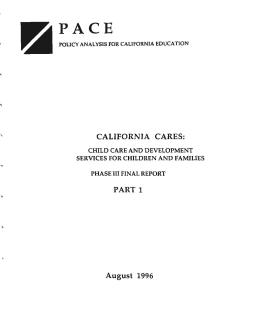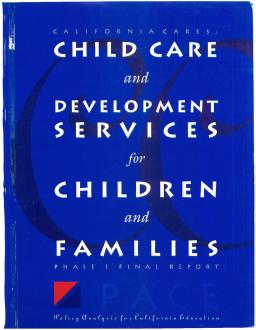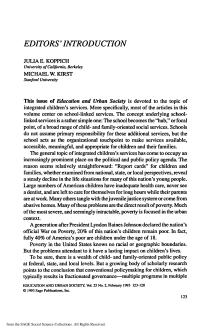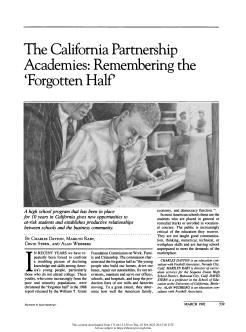Published
Summary
This study examines student mobility in California, particularly at the secondary level. It investigates the incidence, consequences, and causes of non-promotional school changes and offers strategies to address the issue. It also draws on an extensive dataset from various sources, including surveys and interviews with California students, parents, and schools. The findings highlight the negative impact of student mobility on educational achievement and suggest that families, schools, community agencies, and policymakers should take action to mitigate its harmful effects.
Published
Summary
Student mobility, or non-promotional school changes, is a widespread problem that harms students' educational achievement. This report examines the incidence, consequences, and causes of mobility among California students and schools, drawing on surveys of students, parents, and schools, interviews with mobile students and their parents, and interviews with school administrators, counselors, and teachers. The report summarizes the findings on the causes and consequences of mobility and offers strategies for reducing needless mobility and mitigating its harmful effects.
Implications for Equity, Practice, and Implementation
Published
Summary
In 1996, CA launched a $1 billion class size reduction (CSR) initiative to improve early literacy. The initiative provides $800 per student to schools reducing class size to 20 or fewer in first, second, and/or third grade, and kindergarten. CSR was funded due to a state revenue surplus and the belief that smaller classes would enhance early literacy. CA ranked second to last in national reading tests in 1994, and class sizes averaged around 28.6 students per K-3 classroom. While educators and the public show enthusiasm, the success of CSR in enhancing academic achievement is yet to be seen.
The Influence of Household Support, Ethnicity, and Parental Practices
Published
Summary
An investigation of the family factors and practices that influence parents' choice of center-based programs for young children. Maternal education, child's age, and availability of social support were found to be significant factors in center selection. African-American families were more likely to choose center-based care than white or Latino families, and parental practices related to early literacy development and close supervision also affected center selection. The study highlights the importance of considering selection processes when assessing the effects of early childhood programs.
Child Care and Development Services for Children and Families—Phase III Final Report, Part 2
Published
Summary
Phase III of the California Cares report sought to analyze preliminary recommendations and involve the childcare and development community to redesign policies. Work groups and field representatives discussed proposals for improving services, with over 80 contributors. The project studied nine critical policy restructuring questions and Part Two of the report includes reports from eight tasks and summary information.
Child Care and Development Services for Children and Families—Phase III Final Report, Part 1
Published
Summary
Phase III of the California Cares report aimed to redesign childcare and development policy, with input from the community and representatives from three agencies. Work groups and traditional research projects were conducted to study nine questions deemed critical to policy restructuring. Part II of the report includes working papers for all tasks except state governance, which is included in Phase III.
California's History in Child Care and Development
Published
Summary
New curriculum manuals have been created to address the expanding field of school-age childcare, including Kids' Time: A School-Age Care Program Guide. Other widely-recognized materials include Just Kids, Preparing for Mass Disasters, and A Guide for Training and Recruiting Child Care Providers to Serve Young Children with Disabilities. The benefits of childcare include fully-employed parents, self-sufficient families, and children who succeed in school due to the aid of childcare programs. Reducing Exceptional Stress and Trauma, a guide on coping with violence, will be published this year.
Child Care and Development Services for Children and Families—Phase II Final Report Executive Summary
Published
Summary
The California Cares Project, conducted by PACE for the California Department of Education, Social Services & Office of Child Development & Education, culminates in this report. The project was initiated in response to AB 2184, which sought to consolidate all childcare and development programs to streamline the system. The report is divided into two parts: Part I analyzes current obstacles to a seamless system and Part II presents a conceptual model and decision procedure for program and funding allocation and governance. Phase III will refine recommendations and work towards implementation.
Child Care and Development Services for Children and Families—Phase I Final Report
Published
Summary
The California Department of Education, Social Services, and Governor's Office of Child Development and Education selected PACE to analyze issues and options for improving California's childcare system. PACE will produce a report with optional approaches for improving access, quality, and funding of childcare services, including alternative systems and policy models. Phase I includes analysis of childcare issues and programs, literature reviews, and experiences of other urban states. This report summarizes Phase I's work.
Editors' Introduction
Published
Summary
The concept of school-linked services is to make social services available to children and families through the school acting as an organizational touchpoint. This idea has become increasingly prominent due to the declining life situations of many American children, particularly those in urban areas, who face poverty-related issues like inadequate healthcare, juvenile justice involvement, and abusive homes.
Remembering the "Forgotten Half"
Published
Summary
US high school students, especially those who do not attend college, have been found to lack skills and knowledge necessary for the job market. The California Partnership Academies program has been developed to address this issue and has been adopted by over 50 high schools. The program has received support and positive evaluations. Factors contributing to the issue include societal changes, the education system, and changes in the labor market. If these issues are not addressed, the US risks falling behind international competitors and a lower standard of living.
Published
Summary
This study compares the post-secondary experiences of graduates from California Partnership Academies with their matched comparison groups. The findings show that Academy graduates are doing equally well as comparison students in the first year or two after graduation, indicating that Academy programs have not achieved higher graduation rates at the expense of lower success rates after high school. However, there may be more subtle differences between the two groups that are not detectable by simple measures.
